Battery & Power
Aluminum Air Battery

PROJECT LEADS: McGregor Stadtmiller & Stephen Bagley
TEAM: Grace Li, Michael Li, McGregor Stadtmiller, Stephen Bagley, Andrew MacDonald, Shirley Chen
The aluminum air battery is a non-rechargeable battery with a very high energy density. The anode consists of an aluminum sheet, which is separated from the cathode, a carbon paste, via filter paper. The whole cell is wetted with KOH electrolyte. Multiple of these cells are stacked up in series to produce a power output large enough to power the car. Our teams current goals are to create a calibration curve to get a very accurate understanding of our expected velocity.
Alkaline Battery

PROJECT LEAD: Ming Ye
TEAM: (Back Row) Wesley Booth, Nicholas Bourlier, Ming Ye, Ian Yu; (Front Row) Carolina Gutierrez, Roxana Martinez
The alkaline battery has a zinc paste anode and a manganese dioxide cathode with sodium hydroxide as the electrolyte. The battery is assembled in a stacked cell format in which each cell is layered with the anode paste, a filter paper separator wetted with electrolyte, and the cathode paste. The plan for this year is to optimize the stack assembly configuration for maximum current output and then calibrating the battery with the car.
Biofuel Internal Combustion Engine

PROJECT LEADS: Jonathan Ngan & Edward Shin
TEAM: Winston Ou, John Shin, Edward Shin, Jefrey Nacar, Ben Han, Jonathan Ngan(not pictured)
Our team decided to look into biodiesel as an alternative fuel source that could be used to power an internal combustion engine. Biodiesel has been proven to be a viable fuel source and stands out as being a great source of green energy. We synthesize our biodiesel using three simple ingredients: methanol, cooking oil, and Pottasium Hydroxide.
Experimental Battery
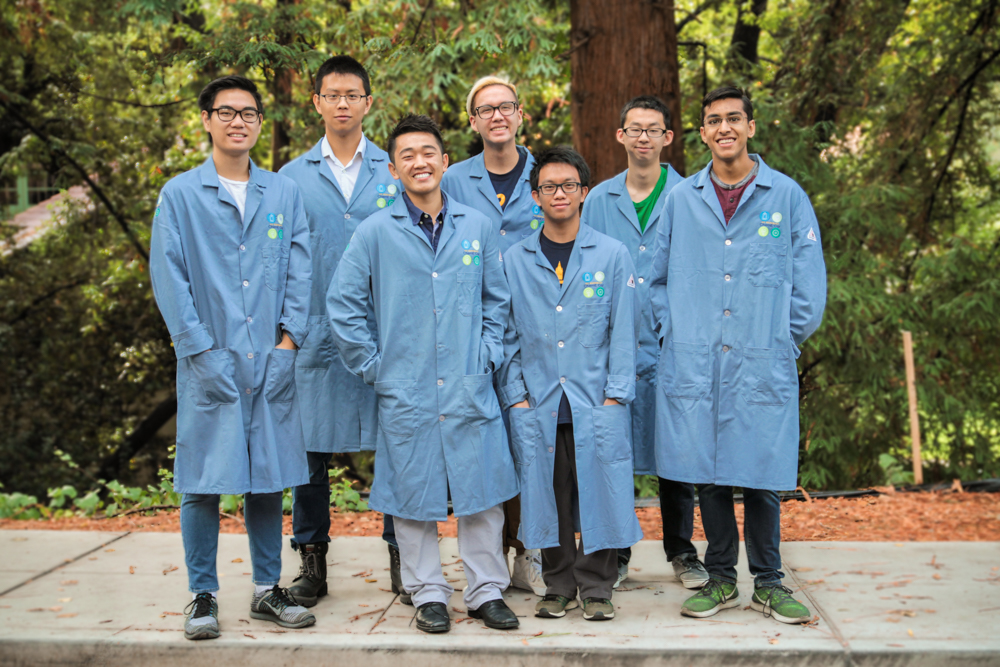
PROJECT LEADS: Richard Sim & Ryan Yao
TEAM: (back row) Brian Law, Ryan Yao, Luke Langford, William Cheng, Samay Garg; (front row) Richard Sim, Derrick Cheng, Rahul Dhiman (not pictured)
As experimental battery, we test for the viability of different metal-air battery chemistries. Currently, we are investigating Magnesium-air as a potential battery for the chassis. Some of the issues that must be addressed before it can be used are corrosion and polarization of the electrodes. Furthermore, our team members will be given individual projects with the goal in specializing them in one specific component of the battery. During the spring semester, we hope to finish testing of a new gas diffusion layer and AZ31 alloy.
Hydrogen Fuel Cell

PROJECT LEADS: Murali Subramanian & Vishnu Dharmaraj
TEAM: Irene Kim, Murali Subramanian, Ashutosh Bhadouria, Vishnu Dharmaraj, Vaikunth Balaji
The really cool thing about the Hydrogen Fuel Cell is that it runs just on Hydrogen gas - because we can get the oxygen required for the reaction from air. Hydrogen gas is sent through one plate and air (which contains oxygen) is sent through the other. Hydrogen is oxidized at the anode, while oxygen is reduced at the cathode. This produces a potential difference which is used to power the circuit and in turn the car.
Pneumatic

PROJECT LEAD: Rajashree Bhattacharya
TEAM: Rajashree Bhattacharya, Sharon Lau, Tina Luong, Ronald Kam, Rohit Rungta
A gas-production reaction builds pressure within a tank, and that gradient is utilized for propulsion of the car. Regulated air is sent to a pneumatic motor which directly turns the chassis wheels. Our goals for this semester are to determine viable reactions and begin calibration of pressure build-up against reagant concentrations.
Thermoelectric
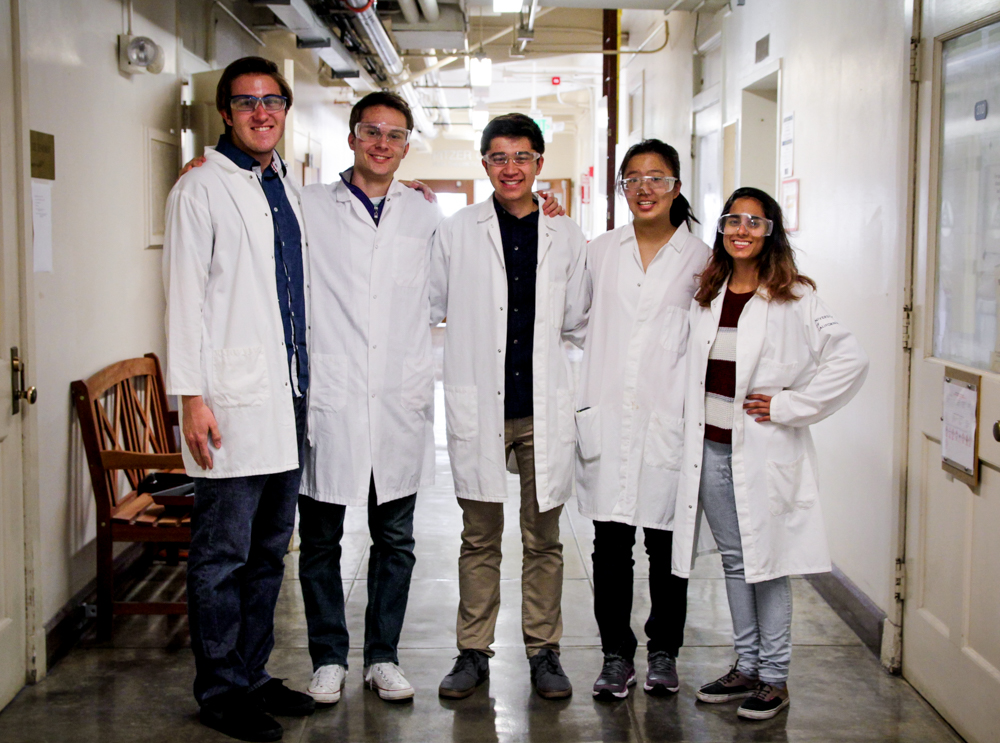
PROJECT LEAD: Ethan Woodbury
TEAM: Jacob Zamojc, Patrick Negulescu, Ethan Woodbury, Tiffany Unsulangi, Sanya Sehgal, Tasneem Khan (not pictured)
Our battery uses several thermoelectric generators (TEGs) to generate power for the car. TEGs are essentially fancy pieces of metal that generate an electric current when one side is exposed to a high temperature and the other is exposed to a low temperature. We are using the reaction between sodium sulfite and bleach as our hot side and the sublimation of dry ice in acetone as our cold side. Our goal for this year is to build the chassis for our battery as soon as possible so we can begin testing and calibrating our battery with the car.
Zinc Air Battery
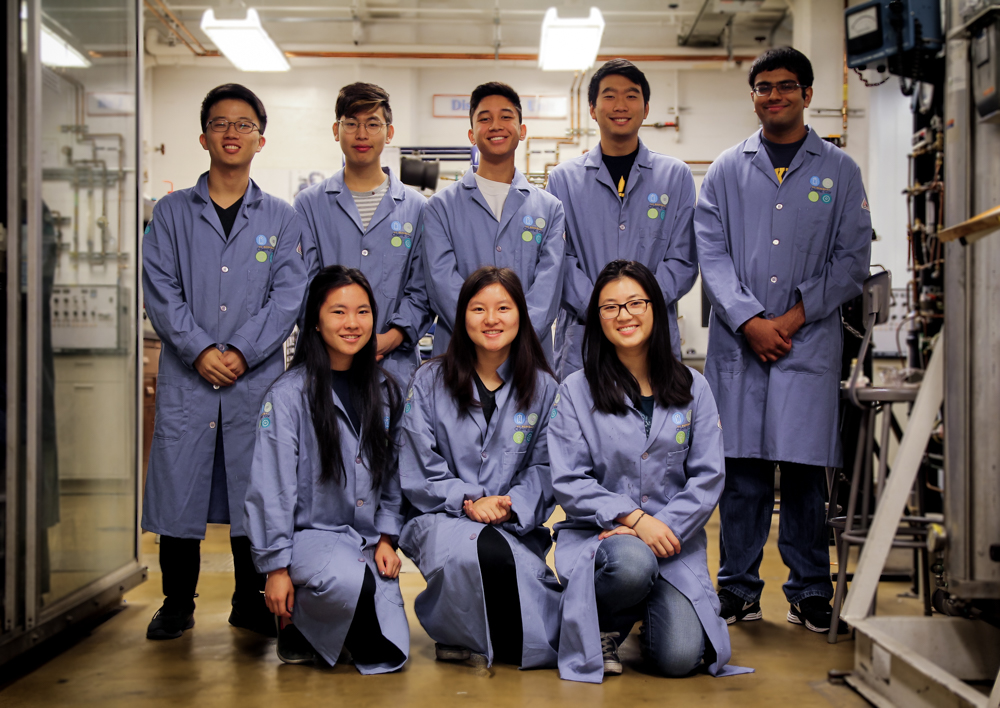
PROJECT LEAD: Parth Patel
TEAM: (back row) Taehun Kim, Won Jun Ryu, Jarad Gonzales, Alexander Yao, Parth Patel; (front row) Amanda Awan, Emmy Yu, Helen Yan
The zinc-air battery uses a zinc anode, a graphite-based cathode, and potassium hydroxide for the electrolyte. Each cell will also use filter paper as a separator and copper for a current collector. Our plan is to spend the first part of the year testing additives or modifications to our current set-up and then spend the second part of the year choosing a design for further calibration and testing.
Control
Chemiluminescence Clock
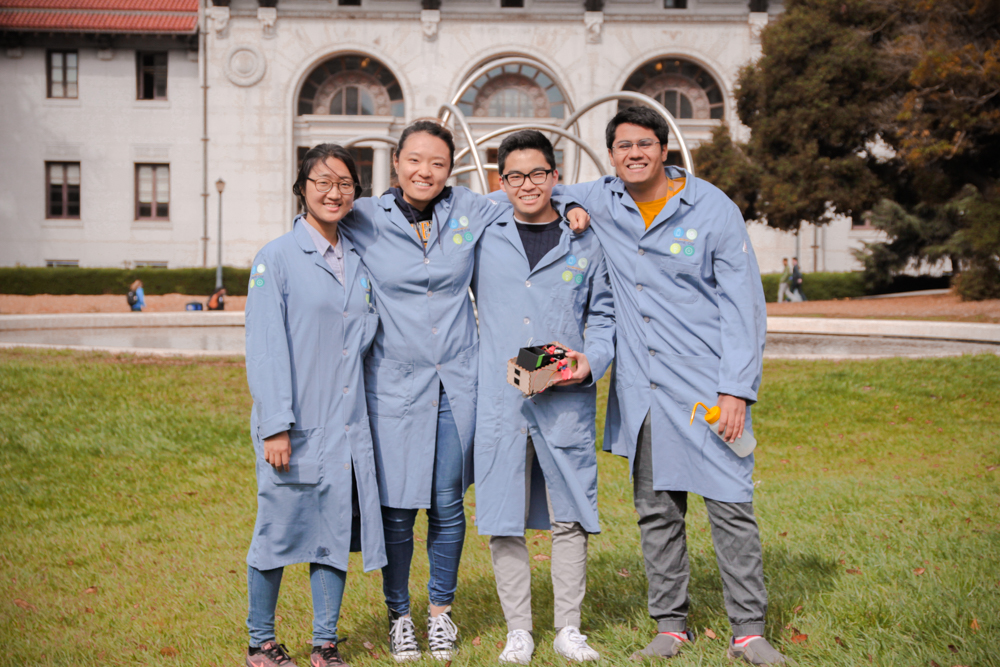
PROJECT LEAD: Sharon Tian
TEAM: Sarah Lee, Sharon Tian, Samuel Ng, Vedant Vaidya, Rodrigo Fregoso (not pictured)
Luminol when oxidized will emit a blue glow of light. Our goal is to modify the luminol reaction so that the fluorescence emitted can be intense enough for the photosensor to detect and long enough to be calibratable.
Enzymatic Clock
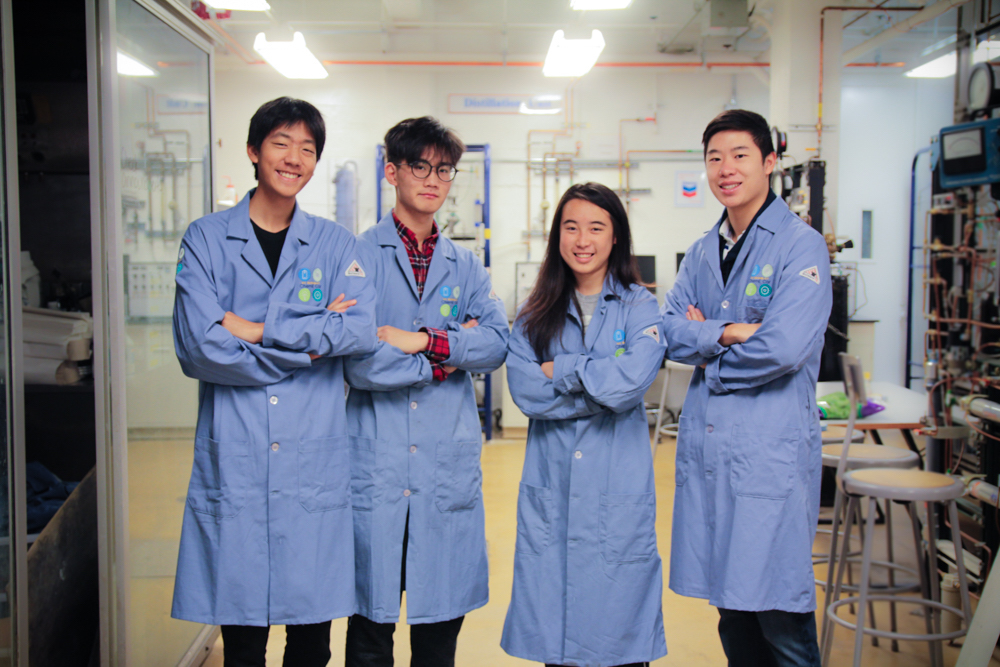
PROJECT LEAD: Annie Wu
TEAM: Kevin Xu, Jason Liang, Annie Wu, Justin Yeung
Enzymatic clock reaction is controlled by the rate of decomposition of hydrogen peroxide through extracted catalase. Gas formation from the decomposition pushes a dye solution up a rubber tubing until it reaches the level of a photosensor that acts as a switch to stop the car. Our goal for the year is to determine what parameters will give the most consistent calibration times.
Experimental Control

PROJECT LEAD: Aayush Patel
TEAM: Reini Lin, Jumin Park, Aayush Patel, Neehar Duvvuri, Sean Park
The experimental control team uses the reaction between alginate and calcium to transform a liquid into a gel. Two aqueous solutions, one of calcium chloride in water and one of sodium alginate in water, are mixed together. The resistance of the solution is measured just prior to mixing the two solutions, and is monitored as the reaction progresses. When the resistance reaches a predetermined value, that is considered the stop time of the reaction. Our goal for the year is to attain some consistency in our reaction and then develop a calibration curve.
Electrical

PROJECT LEAD: Stephan Kaminsky
TEAM: Jeremy Murphy, Alex Cardia, Stephan Kaminsky
The electrical team devises ways of converting the chemical clocks teams data into voltages so that we can determine if the car should be on or off. We also turn on and of the power to the motor from the battery. Also we are trying to devise methods to help increase data collection for the different battery teams by figuring out ways to measure voltage and current from the batteries plus measure the time it takes to go a certain distance in hopes to calculate a more accurate velocity.
Mechanical
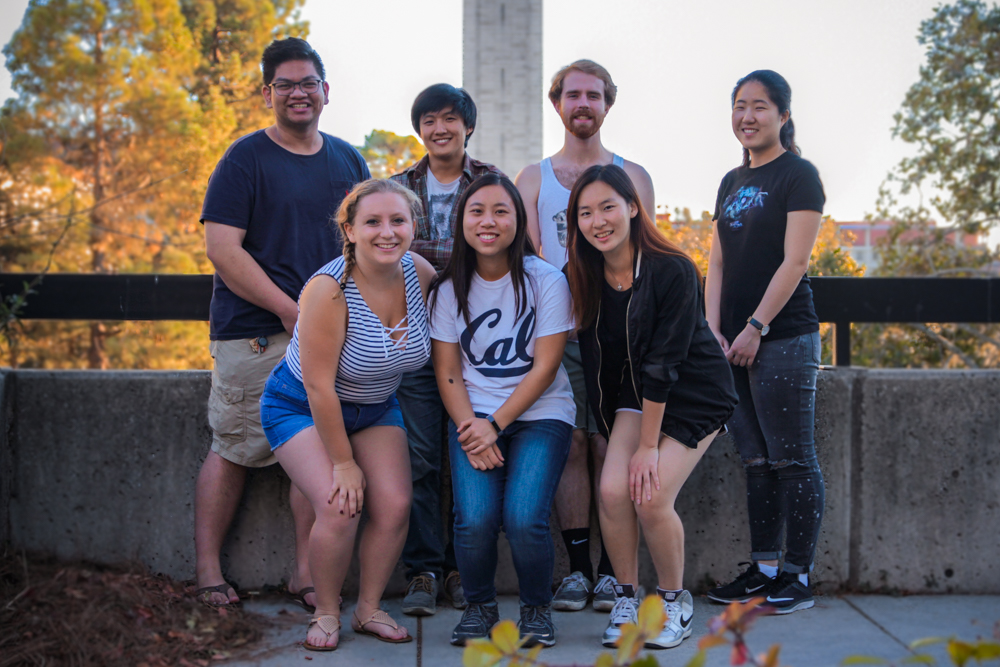
PROJECT LEAD: Lance Moll
TEAM: (Back row) Lance Moll, Austin Lim, Mace Grunsfeld, Audrey Zhao. (Front row) Ariel Plantz, Felicia Trinh, Nancy Ye, James Park (not pictured)
Our team focuses on creating a chassis for the chemical teams to use and test for competition. This year we're planning on creating two more competition chassis, as well as two for research and development for various testing purposes. We utilize CAD software, to create models for the chassis as well as containment units for the chemical teams. We also use tools such as laser cutters and 3D printers to fabricate the chassis and various parts for the chassis. We're currently finishing up the two competition chassis and working on fabricating new containment units for the chemical teams.
Media
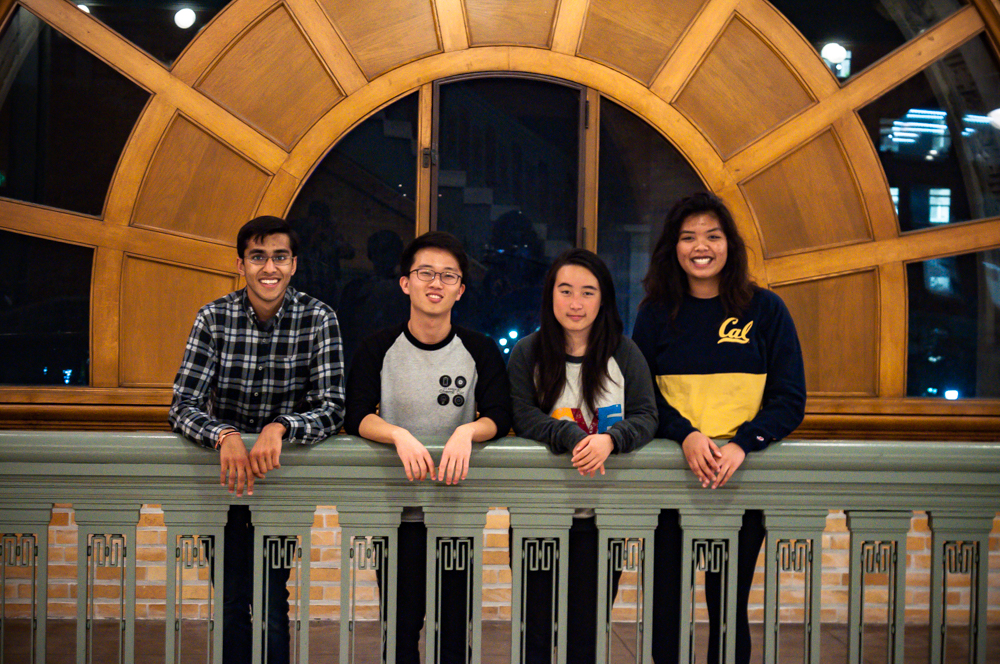
PROJECT LEAD: Jilian Cabornay
TEAM: Samay Garg, Tae Kim, Annie Wu, Jilian Cabornay
The media team of ChemE Car covers the traditional roles of webmaster, historian, and graphic designer/public relations. We are in charge of updating this website, maintaining the facebook page, photographing team members and events, t-shirt/apparel design, and overall club publicity. In the spring semester, we also oversee the poster design that is competed at regional competition each year. The media team is always looking for creative minds who are willing to learn, so feel free to reach out!
Jeopardy
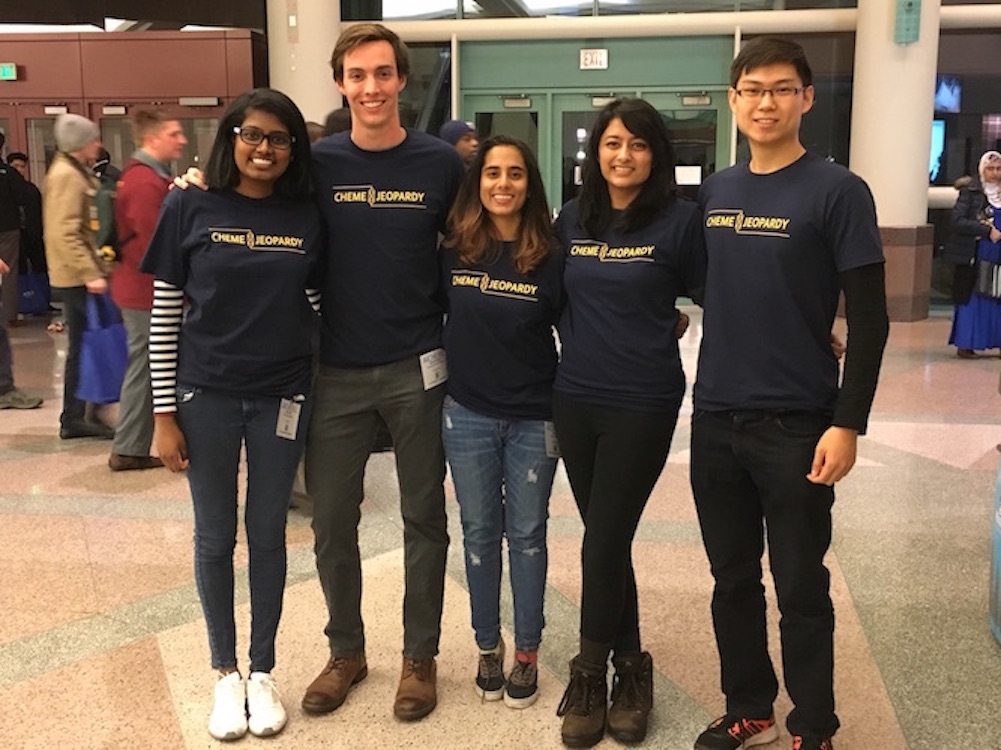
PROJECT LEAD: Rahashree Bhatta
TEAM: Meghna Raj, McGregor Stadtmiller, Sanya Sehgal, Rajashree Bhatta, Richard Lin
Jeopardy Game utilizing questions from Chemical Engineering Undergrad Coursework. ChemE Jeopardy Games are held at the Regional Conference level in the Spring. The Championship teams from each of the 9 Regional Conferences go on to compete at the Annual Student Conference in the Fall to determine the Champion school for the year.
back to top
